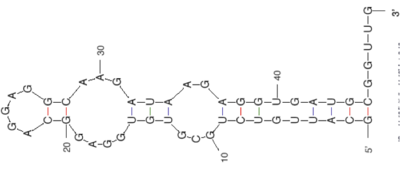20.109(S11):Module 1: Difference between revisions
(New page: {{Template:20.109(S11)}} <div style="padding: 10px; width: 640px; border: 5px solid #3399FF;"> ==Module 1== '''Instructors:''' [http://web.mit.edu/be/people/niles.htm Jacquin Niles] an...) |
No edit summary |
||
| Line 7: | Line 7: | ||
'''Instructors:''' [http://web.mit.edu/be/people/niles.htm Jacquin Niles] and [[User:AgiStachowiak| Agi Stachowiak]] | '''Instructors:''' [http://web.mit.edu/be/people/niles.htm Jacquin Niles] and [[User:AgiStachowiak| Agi Stachowiak]] | ||
'''TA:''' Carrie Thompson | '''TA:''' [[User:Carrie M Thompson| Carrie Thompson]] | ||
In this module you will investigate RNA aptamer selection. You may already be familiar with biological entities that bind to specific molecules, such as antibody proteins or their peptide derivatives. Short fragments of RNA can also have high-order structures that allow them to bind a target molecule with good affinity and specificity; successful binders are called aptamers. Normally, RNA aptamers that bind particular targets are found by screening many candidates at random in a process called SELEX, or systematic evolution of ligands by exponential enrichment. (Predictive computational tools can also be used to design rather than select aptamers.) In the coming weeks, you will essentially perform one round of SELEX. Because SELEX typically takes several rounds to isolate target-binding aptamers, you will start with a known RNA mixture rather than than a completely random library. Your goal will be to explore what experimental parameters affect the enrichment of a heme-binding RNA aptamer from a mixture of heme-binding and non-binding RNAs. | In this module you will investigate RNA aptamer selection. You may already be familiar with biological entities that bind to specific molecules, such as antibody proteins or their peptide derivatives. Short fragments of RNA can also have high-order structures that allow them to bind a target molecule with good affinity and specificity; successful binders are called aptamers. Normally, RNA aptamers that bind particular targets are found by screening many candidates at random in a process called SELEX, or systematic evolution of ligands by exponential enrichment. (Predictive computational tools can also be used to design rather than select aptamers.) In the coming weeks, you will essentially perform one round of SELEX. Because SELEX typically takes several rounds to isolate target-binding aptamers, you will start with a known RNA mixture rather than than a completely random library. Your goal will be to explore what experimental parameters affect the enrichment of a heme-binding RNA aptamer from a mixture of heme-binding and non-binding RNAs. | ||
Revision as of 14:54, 17 January 2011
Module 1
Instructors: Jacquin Niles and Agi Stachowiak
TA: Carrie Thompson
In this module you will investigate RNA aptamer selection. You may already be familiar with biological entities that bind to specific molecules, such as antibody proteins or their peptide derivatives. Short fragments of RNA can also have high-order structures that allow them to bind a target molecule with good affinity and specificity; successful binders are called aptamers. Normally, RNA aptamers that bind particular targets are found by screening many candidates at random in a process called SELEX, or systematic evolution of ligands by exponential enrichment. (Predictive computational tools can also be used to design rather than select aptamers.) In the coming weeks, you will essentially perform one round of SELEX. Because SELEX typically takes several rounds to isolate target-binding aptamers, you will start with a known RNA mixture rather than than a completely random library. Your goal will be to explore what experimental parameters affect the enrichment of a heme-binding RNA aptamer from a mixture of heme-binding and non-binding RNAs.
We thank 20.109 instructor Natalie Kuldell for helpful discussions and for acquiring funding for module development.

Module 1 Day 1: Amplify aptamer-encoding DNA
Module 1 Day 2: Purify aptamer-encoding DNA
Module 1 Day 3: Prepare RNA by IVT
Module 1 Day 4: Purify RNA and run affinity column
Module 1 Day 5: RNA to DNA by RT-PCR
Module 1 Day 6: Post-selection IVT and journal club
Module 1 Day 7: Aptamer binding assay
Module 1 Day 8: Journal club
